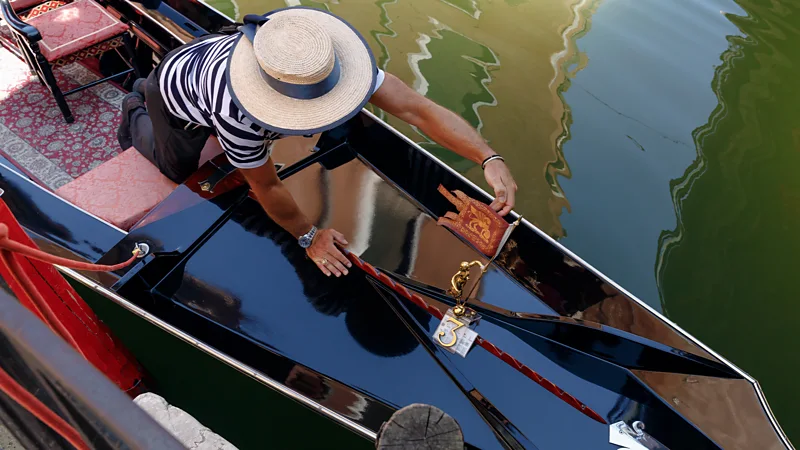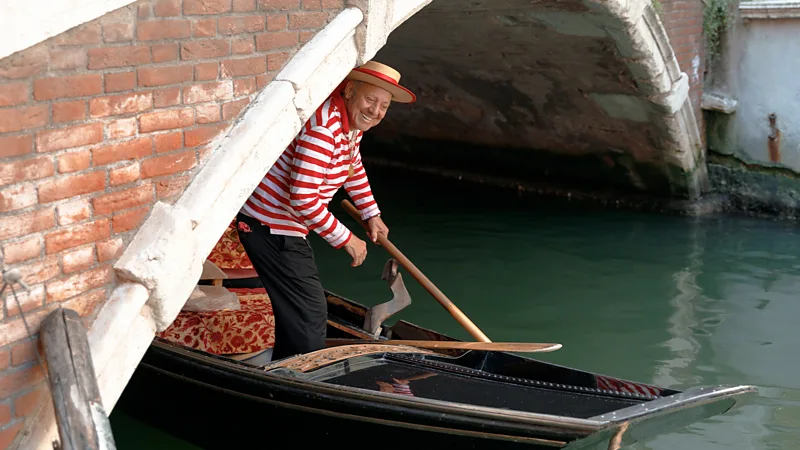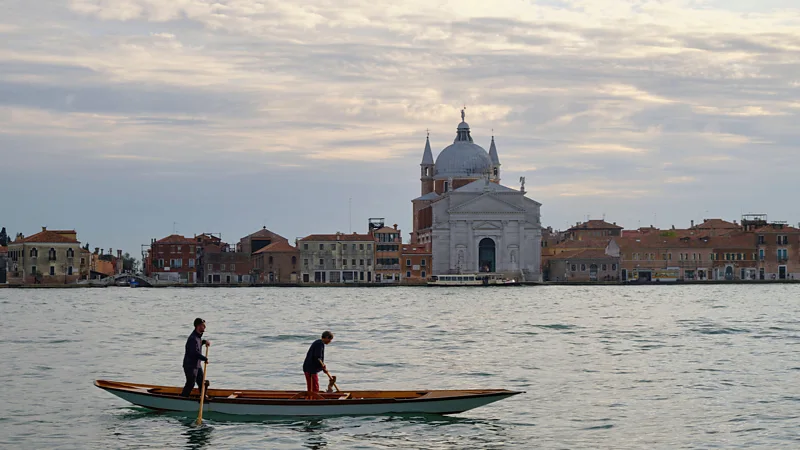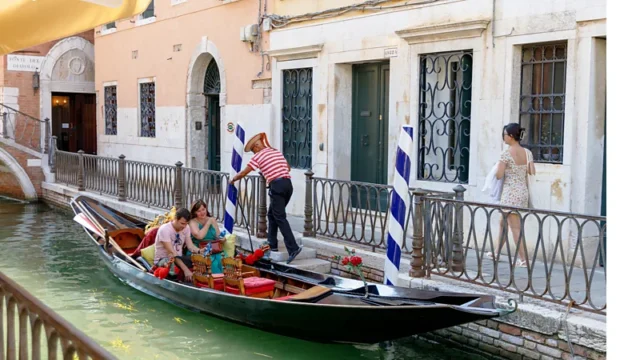Introduction to Venice’s Sandolo Boats
Venice, known worldwide for its picturesque canals and iconic gondolas, holds a lesser-known treasure in its waterways: the “sandolo” boats. These traditional vessels, which predate the gondola, offer travelers an intimate and unique experience of Venice by navigating narrow canals that larger boats cannot access. The sandolo’s history and design reflect a different side of Venetian culture and offer a peaceful, authentic way to explore Venice beyond the bustling tourist areas.
The Sandolo: A Historical Icon of Venice
The sandolo is smaller than the gondola and has played an essential role in Venetian life for centuries. Characterized by its flat-bottom design and a distinctive steel curl at the prow, the sandolo was traditionally used by Venetians for daily tasks such as fishing, transporting goods, and navigating shallow lagoon waters. Unlike gondolas, which have been primarily used for passenger transport and are renowned for their ornate features, the sandolo has always been a practical workboat.
The first recorded mentions of sandoli date back to 1292, showcasing its longstanding place in Venetian history. These boats were initially used for diverse purposes, including fishing, racing, and transporting materials across the Venetian Lagoon. As Venice evolved, so did the boats, with sandoli remaining a staple for families who relied on them for essential activities, even as gondolas rose to prominence.

Design Differences Between Sandolos and Gondolas
While sandolos share similarities with gondolas, they differ in several ways that enhance their practicality. Unlike gondolas, which have two pointed ends and an asymmetrical design, sandoli have a simpler structure with a flat stern and a painted prow. The design of sandoli allows the rower to stand in the middle, giving a balanced rowing stance and enabling faster travel through shallow waters. This central positioning also lets the sandolo carry heavier loads with less risk of tipping, a valuable trait for those transporting goods across Venice’s waterways.
The Decline and Revival of Sandolo Rowing
Although the sandolo was once widespread, it gradually lost popularity to the more manageable and visually striking gondola. Many Venetians found that rowing a gondola required less effort, especially in narrow canals, which led to a decline in sandolo use over time. Today, the gondola industry is a regulated trade with 433 licensed gondoliers, whereas only around 20 sandolo rowers, or “sandolisti,” remain.
However, sandoli have experienced a recent resurgence among those seeking a quieter and more culturally rich experience. Riding in a sandolo provides a unique opportunity to explore areas like the Jewish Ghetto, Ponte dei Greci, and other quieter parts of Venice that gondolas are often unable to access.
The Modern Sandolo Experience
For tourists looking for an authentic Venetian experience, a ride in a sandolo offers a distinct perspective of the city. Available from nine “stazi,” or stations, sandolo rides cost the same as gondola rides and offer a half-hour journey through the narrow canals. A sandolo can navigate into secluded areas and explore hidden corners that remain out of reach for larger boats, making it an ideal choice for those who want to experience Venice in a more intimate way.
Price and Availability of Sandolo Rides
The cost for a sandolo ride is similar to a gondola. Daytime rides between 09:00 and 19:00 last about 30 minutes and cost €90 per boat, which accommodates up to five passengers. Evening rides from 19:00 to 04:00 cost €110 for 35 minutes, providing an even more tranquil experience as Venice’s lights reflect off the canals.
A Family Tradition: Passing Down the Sandolo Craft
Sandolo rowing has been a tradition passed down through generations in many Venetian families. Families like Padoan’s and Scarpa’s have dedicated their lives to preserving the sandolo tradition. For instance, Luca Padoan learned to row with his grandfather at the age of seven, while Valentino Scarpa returned to the family trade after university. The family-centered nature of sandolo rowing has kept the art alive, allowing sandolisti to share the rich history of these boats with visitors.

The Role of Aspiring Sandolisti
In recent years, the opportunity to become a sandolista has opened up to aspiring rowers whose families were not traditionally involved in the trade. The Municipality of Venice now organizes training and licensing programs for those who want to become sandolisti. Applicants must complete a professional navigation course and pass both a rowing and swimming test. This initiative has encouraged a new generation to embrace the sandolo, contributing to the boat’s preservation and Venice’s cultural heritage.
Sandolo Rowing Techniques and Traditions
Sandolo rowing uses a technique called “voga alla veneta,” which involves rowing with a single oar from a central stance. However, some areas of the lagoon, such as Caorle, Marano, and Grado, historically employed a dual-oar technique known as “voga alla vaesana.” This method allowed rowers to move quickly across open waters and was particularly useful for fish farming and other activities in the Venetian lagoon.
While gondolas are rowed asymmetrically from the side, sandoli are symmetrical, allowing rowers to stand in the center. This balanced approach provides greater speed and maneuverability, especially in areas with shallow waters and tight passages.
Discovering Venice Through the Eyes of a Sandolista
For many sandolisti, rowing a sandolo is not just a job but a way of life. Chiara Favaro, the daughter of a sandolo rower, explains that when you ride in a sandolo, you experience the city differently. Sandolisti often share stories passed down through generations, offering tourists a personal look at Venice’s history and cultural roots. These local stories provide an insider’s view of the city, from tales of ancient trade routes to family memories of Venice’s unique canals.
A Unique Job with a Strong Cultural Heritage
Sandolisti see their work as more than a profession; it is a way to keep Venice’s cultural heritage alive. Scarpa, a dedicated sandolo rower, explains that each sandolo is unique and represents a piece of Venice’s history. Many rowers feel that operating these boats makes them “more Venetian” and allows them to connect with their heritage on a deeper level.
As tourists step off the sandolo, sandolisti hope they feel a deep connection to Venice’s history, having experienced the city’s beauty, sounds, and ambiance in an unparalleled way. The sandolo allows visitors to savor the essence of Venice, far removed from the bustling crowds.
A Growing Interest in Sandolo Rides
With increasing interest in cultural tourism, more travelers are seeking out sandolo rides as a way to experience Venice differently. By opting for a sandolo, tourists can discover the quiet, hidden canals and local areas that have preserved the city’s authenticity over the centuries.
Local tourism initiatives are also working to promote sandolo rides as part of sustainable tourism efforts, encouraging tourists to explore the city without overcrowding popular sites. With Venice facing challenges from mass tourism, the sandolo offers an eco-friendly alternative, allowing tourists to enjoy the waterways without adding strain to the city’s infrastructure.
Conclusion: Embracing Venice’s Sandolo Legacy
Sandolo boats offer travelers a unique glimpse into Venice’s past and a peaceful way to navigate its canals. For those who wish to escape the usual tourist trail, a sandolo ride promises an intimate experience through quieter neighborhoods, authentic Venetian culture, and a deeper understanding of the city’s history.
From the skilled rowers preserving family traditions to the locals who continue to use these boats, the sandolo remains a powerful symbol of Venice’s resilience and adaptability. As more visitors embrace this form of transport, they contribute to the preservation of Venice’s cultural legacy and support a unique, time-honored tradition.












